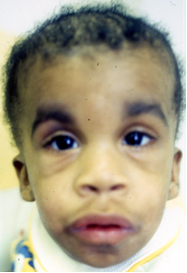Premature Infant With Motor Delays
This 1-year-old African-American boy is being followed for developmental delays. His 35-year-old mother has no known health problems, and this was her third pregnancy.Premature delivery at 27 weeks was uncomplicated, yielding appropriate birth weight and Dubowitz scores for gestational age.

This 1-year-old African American boy is being followed for developmental delays. His 35-year-old mother has no known health problems, and this was her third pregnancy. She had early spotting at 8 weeks’ gestation with later bed rest and medical therapy for threatened abortion. Premature delivery at 27 weeks was uncomplicated, yielding appropriate birth weight and Dubowitz scores for gestational age.
The baby was mechanically ventilated for 3 weeks, and required 60 days of nursery care. Early feeding with pumped breast milk and formula was complicated by tongue-thrusting, spitting, and constipation, despite several formula changes. GERD was diagnosed when the child was 3 months old. He gained weight slowly, with frequent head-tilting to one side after feeds. He was given palivizumab (Synagis) to prevent RSV and had no cardiac or pulmonary problems.
Motor milestones included rolling over front to back at 3 months, back to front at 5 months, and maintaining a sitting position at 9 months. He had increased muscle tone with persistence of grasp and tonic neck reflexes. Concerns about his facial appearance and delays prompted genetic referral that documented normal chromosome studies with no syndrome diagnosis.
Review of systems is normal except for intermittent constipation, irritability after feeds that was initially diagnosed as colic, and persistent posturing after eating with tilting of his head to the side.
The family history includes 2 healthy older siblings, both born prematurely. The parents are healthy, each with several healthy siblings and no family history of birth defects, mental disability, or early-onset cancers.
Physical examination
The height was in the 25th percentile for age, weight in the 5th percentile, and head size in the 25th percentile. The boy was very active, with exaggerated reaction to sound or touch. The facial appearance was somewhat unusual, with sparse hair, prominent and arched eyebrows, subcanthal folds, and generous lips; these features were very similar to those of the father when childhood photographs were inspected.
Results of cardiac, pulmonary, and abdominal exams were normal; there were no surface anomalies or disproportion of the extremities. The joints were tight with mild limitation of extension in the elbows and knees. Neurologic exam showed increased deep tendon reflexes with clonus in the lower extremities.
1. What diagnoses besides prematurity are likely in this child?
2. What preventive health care issues should be addressed?
Answer on the next page
ANSWER: Cerebral palsy (CP)1-3 and persistent GE reflux with posturing (Sandifer syndrome).4
CP involves changes in motor function and tone with spasticity, GI problems, and persistence of neonatal reflexes. Constipation and GE reflux are common because of hypertonicity and changes
in sphincter tone and autonomic function. Reflux can be severe with posturing and pulmonary changes.
This child’s face seems unusual, but no specific syndrome or chromosome aberration was identified. Although inspection of parental childhood photos demonstrated resemblance to the father as an infant, follow-up of the child as one with a possible syndrome and risks for multiple anomalies is important.
CP has multiple congenital and genetic causes and is a clinical diagnosis based on a typical pattern of neurologic changes.1-3 In most cases, there are prenatal alterations, such as the threatened abortion here, which support congenital causes rather than birth asphyxia. Progressive decrease in head size is typical of hypoxic-ischemic encephalopathy (HIE), and head MRI plus genetic studies are often indicated to exclude chromosome changes and brain anomalies. Periventricular leukomalacia is associated with HIE but also with metabolic disorders such as glutaric aciduria type I. TORCH (toxoplasmosis, other, rubella, cytomegalovirus, herpes) titers are useful for children with microcephaly, since congenital infection may yield a CP pattern.
Preventive health care for CP is best directed by a designated specialty clinic with neuromotor, developmental pediatric, orthotic, and therapy specialists.3 Specific learning differences and ADHD can occur during school years. Neurology and ophthalmology referral for treatment of dysphagia, drooling, oculomotor problems, and spasticity should be initiated if a CP clinic is not accessible. Orthopedic and orthotic evaluation is often needed for contractures and deformations.
References:
REFERENCES:1. Cooley WC; Committee on Children With Disabilities. Providing a primary care medical home for children and youth with cerebral palsy. Pediatrics. 2004;114:1106-1113. http://aappolicy.aappublications.org/cgi/content/full/pediatrics;114/4/1106. Accessed July 2011. 2. Rubin IL, Crocker AC, eds. Developmental Disabilities: Delivery of Medical Care for Children and Adults. Philadelphia: Lea and Febiger; 1989. 3. Wilson GN, Cooley WC. Preventive Health Care for Children With Genetic Condition: Providing a Medical Home. 2nd ed. Cambridge, UK: Cambridge University Press; 2006. 4. de Ybarrondo L, Mazur JL. Sandifer's syndrome in a child with asthma and cerebral palsy. South Med J. 2000;93:1019-21. http://emedicine.medscape.com/article/931761-overview. Accessed July 2011. 5. Stevenson RD. Use of segmental measures to estimate stature in children with cerebral palsy. Arch Pediatr Adolesc Med. 1995;49:658-662. 6. United Cerebral Palsy Association Inc. (www.ucp.org); Ontario Federation for Cerebral Palsy (www.ofcp.on.ca); Scope-About Cerebral Palsy UK (www.scope.org.uk). Accessed July 2011.
Recognize & Refer: Hemangiomas in pediatrics
July 17th 2019Contemporary Pediatrics sits down exclusively with Sheila Fallon Friedlander, MD, a professor dermatology and pediatrics, to discuss the one key condition for which she believes community pediatricians should be especially aware-hemangiomas.